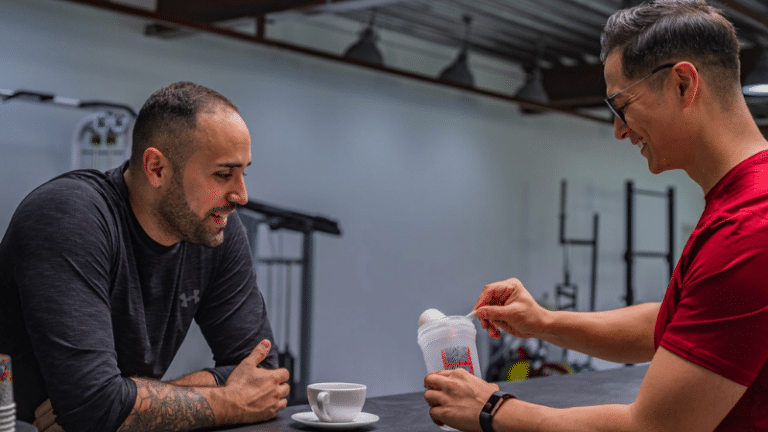How to Get a Smaller Waist (Ultimate Guide)

The main focus of this guide will be on how to get a smaller waist by getting rid of that stubborn fat around your midsection. An improved body physique isn’t the sole reason to want a smaller waist. Quite the opposite, we’ve seen ample evidence that these pockets of fat are more damaging to your cardiovascular health than they are to your appearance.
The Risks of Carrying Excess Fat Around Your Waist
A recent study published by the Journal of the American Heart Association (JAHA) analyzed the results from more than 500,000 people aged 40–69. This study monitored the participants for seven years to determine their risk of heart attack due to excess fat around the abdomen.
As expected, women with more weight around the waist had a 10%–20% higher risk of heart attack. The risk factor was slightly lower for men, though. An important insight obtained from this study is that the waist-to-hip ratio is 18% more accurate than BMI (body mass index) as a predictor of heart attack in women and 6% more accurate in men.
This study is probably one of the driving forces behind the growing interest in how to get a smaller waist and bigger hips. The available heart attack statistics record a greater risk of heart attack from central adiposity because this usually represents an increase in visceral fat, a kind of problematic fat that encases some body organs. Medical experts also caution that a larger waist-to-hip ratio is associated with cardiovascular diseases and diabetes.
What You Need to Know if You’re Trying to Lose Waist Fat
If you are trying to get a smaller waist, here are crucial points to note and the best ways to go about it.
Losing Weight Fast May Not Be in Your Best Interest
Considering the urgency with which people usually want to get rid of an undesirable fat accumulation, it’s crucial you understand how to get a smaller waist safely and with lasting results.
You’ll be able to lose weight around your waist if you follow a well-formulated diet and exercise (a good home rowing machine can come in handy here). Rapid weight loss is typically unhealthy, especially if you’re on a restricted diet and engage in an intensive exercise regime. A major challenge is that you can’t maintain this level of intensity for too long. Upon achieving the desired weight loss, you’re likely to stop or significantly scale back your commitment.
So, to lose weight around your waist and maintain it that way, go slow and steady. You should aim to lose a maximum of 1–2 pounds a week because this slow progress creates the exercise habit, which is critical to maintaining an overall healthy weight in the long run. Suffice to say, diet and exercises for a smaller waist are far better—or rather safer—than any crash program for weight loss.
Not that shedding weight fast doesn’t work, but it’s seldom a long-term solution even if you manage to achieve it. It’s general knowledge that losing weight fast usually involves intensive exercises that put too much demand on your muscles. This energy demand usually generates stress and yields opposite results.
Crash Diets Aren’t the Way to Go
A crash diet is another way to lose weight super fast, involving exercises that make you burn calories. You might need to cut out whole food classes or just reduce your calorie intake. However, while we understand why you’d like to know how to make your waist smaller overnight, crash diets aren’t ideal due to certain health risks they can pose.
Calorie requirements depend on body weight and activity level. Many studies found that long-term drastic diet cuts lead to health problems like fatigue, dizziness, and hair loss. Restrictive diets can also trigger adaptive thermogenesis, which conditions your body to burn calories far below a healthy level.
The more you cut down on your calorie intake, the lower your metabolic rate is going to get. Of course, we are not trying to discourage you from pursuing a healthy caloric deficit that helps you shed one or two pounds a week. The point is that you shouldn’t consume much less than your body needs.
Make Healthy Diet Choices
Diet modifications are an increasingly popular method of choice for shedding excess fat. Here’s how to go about it if you want a smaller waist.
Focus on Protein
The best way to a slim waist is through healthy diet and exercise. About 80% of the actual results will come from nutrition and only 20% from exercise. When trying to lose weight, a balanced diet is necessary. Consume enough protein to rapidly build new cells and repair muscle damage.
Protein helps you to lose weight and also to avoid regaining it. It also keeps you full longer, reducing any tendencies to overeat. While trying to lose weight around your waist, prioritize high-protein foods like eggs, meat, legumes, dairy, and nuts.
Don’t Cut Out Carbs
Be mindful of refined carbs because they digest fast and are likely to spike blood sugar. It’s better to go for fiber foods high in carbohydrates—such as grains—if you’re primarily interested in how to get a smaller waist fast. These will keep you full for a while.
Healthy carbs are important for losing weight without serious adverse effects. Besides scaling down your munchies by providing all the energy you need, they gradually inject sugar into the bloodstream. That said, cutting out carbs won’t lead to slimming your waist overnight—you’ll need to put some time in to see noticeable results.
Make Sure You Eat Enough Fiber
Fiber is a food component that your body doesn’t absorb after digestion. Fiber has many benefits, the most prominent of which are:
- producing a feeling of fullness
- reducing appetite
- moderating the amount of sugar passed into your bloodstream during digestion
Another weight-loss benefit of fiber that made us include it as one of the tips on how to get a smaller waist in male and female adults is that it absorbs fats, water, and nutrients in your gut system.
Track Your Nutrition
Tracking your nutrition is important for losing weight around your waste. Get enough of all six food classes, but maintain a healthy calorie deficit. Taking the right amounts of macronutrients in your food speeds up weight loss when coupled with regular exercise. There are apps designed to help you track your nutrition, such as MyFitnessPal. In short, even though you might not like this answer if you’re looking for recommendations on how to get a smaller waist in a week, the right nutrition and exercise are your safest bet when it comes to lasting weight loss.
Too Much Ab Exercise Won’t Help
One of the biggest misconceptions about weight loss is that targeting specific body areas removes fat from those areas. However, years of practice prove that no tangible results stem from targeted exercises like crunches before bed. The reason isn’t far-fetched—our body anatomy requires whole-body exercises to eliminate fats in the long term.
The bottom line is that abdominal exercises aren’t effective in reducing your waist-to-hip ratio. Instead, focus on the entire body with an overall goal of shedding weight gradually and lastingly.
Increase Your Resistance Training
While targeted exercises may not be the way to go, we do have several recommendations on how to get a slimmer waist via exercises. While you can’t really lose weight in specific areas by isolating a body part for exercise, some whole-body exercises can target certain areas.
Resistance training outperforms all other forms of exercise when it comes to reducing your waist size. Cardio exercise effectively burns more calories without building or retaining muscles. On the other hand, resistance training helps your body build more lean muscles while burning fats. This form of exercise also increases your muscular strength and endurance. Any strength exercise qualifies as resistance training and can help your body lose more fat.
Move More During the Day
If your job requires prolonged sitting at a desk, you probably don’t exercise enough. Our tight schedules sometimes make it difficult to even find time for a simple walk, despite the fact that walking alone can be highly effective in making your waist smaller. Walking improves mental health, prevents hunger spikes, fights weight gain, and sheds body fat, among other benefits.
You can lose 1 lb a week by walking 10,000 steps or more every day. This gets clearer when you understand that 10,000 steps burn at least 500 calories. Even simple exercises like walking upstairs, doing household chores, and playing with your kids burn calories. So, if you lead a sedentary life, including more activities in your daily routine may not give you a super skinny waist overnight but definitely yields tangible results in the long run.
Stress Will Slow You Down
Job-related stress is almost a certainty. As a matter of fact, around 77% of employees experience the physical effects of stress. In addition, family responsibilities and other life events can also generate an overdose of cortisol, the stress hormone.
So if you want to know how to get a slim waist, managing stress effectively is critically important. One of the main reasons for this is the direct relationship between cortisol and insulin resistance—higher cortisol levels impact our body’s ability to maintain stable blood sugar levels. Persistently high cortisol levels eventually lead to fat buildup throughout the body, countering the effect of various ways to get a slimmer waist that you may be trying at the time.
Did you know that certain types of exercise can also cause stress? As unusual as it seems, some workouts can cause stress by demanding too much energy, especially frequent HIIT (high-intensity interval training) exercises. Since it’s impossible to eliminate stress in our lives, you can manage it by:
- meditating
- being mindful
- avoiding caffeine
- getting all the rest and sleep your body needs
Stay Away From Waist Trainers
As tempting as waist trainers might appear, staying clear of them is safer. Unfortunately, waist trainers are a trending option if you look up “how to make your waist smaller” due to their endorsement by celebrities. A critical look at how waist trainers work reveals possible negative effects in the long term.
Waist trainers push down hard against vital organs like the stomach and the liver, so health experts worry about the safety of using them. Because there are no studies on waist trainers, no definitive answer is available on how they might undermine your health. That said, the best way to reduce your waist size is to follow a healthy diet and adopt regular exercise. This won’t slim your waist overnight, but if you stay persistent, results are sure to follow. Of course, if you want to make the process faster, there are plenty of effective weight loss pills out there that might be able to help you.
Drink Water Within 30 Minutes of Waking Up
This practice is known as Japanese water therapy. Many have practiced this habit and enjoyed several health benefits, including weight loss. It reportedly promotes rehydration, which is an important factor in losing weight.
With water occupying space in your stomach and producing a feeling of fullness, your food cravings drop, discouraging unnecessary eating that increases weight gain. It’s scientifically proven that drinking water before eating reduces calorie intake, perhaps not as efficiently as high-quality appetite suppressants, but still to an impressive degree. Drinking water also ramps up resting energy expenditure and ranks as one of the top tips on how to get a smaller waist without exercise. Of course, drinking too much can be dangerous, so make sure to stay within the recommended daily doses.
Cut Out Alcohol
Alcohol is among the biggest culprits of weight gain because it’s a prolific source of empty calories. Namely, it interferes with the activities of major organs necessary for maintaining a healthy weight, such as the liver.
Limit Sugar Intake
Limiting your sugar consumption helps reduce your waist size because too much sugar in the blood increases insulin levels. This can cause fat to collect around the waist and other body parts. The same thing goes for non-sugary foods high on the glycemic index (GI). A good way to curb sugar intake is to look into top-quality sugar substitutes.
Conclusion
While there are many viable suggestions on how to get a smaller waist, the key to reducing your waistline is a combination of patience, healthy diet, exercise, and diligence. Pockets of fat cells around your midsection are undoubtedly difficult to get rid of, so you should only expect results after a long period of dedication and consistency. Any shortcuts will be short-lived, consequential, and even counterproductive.






